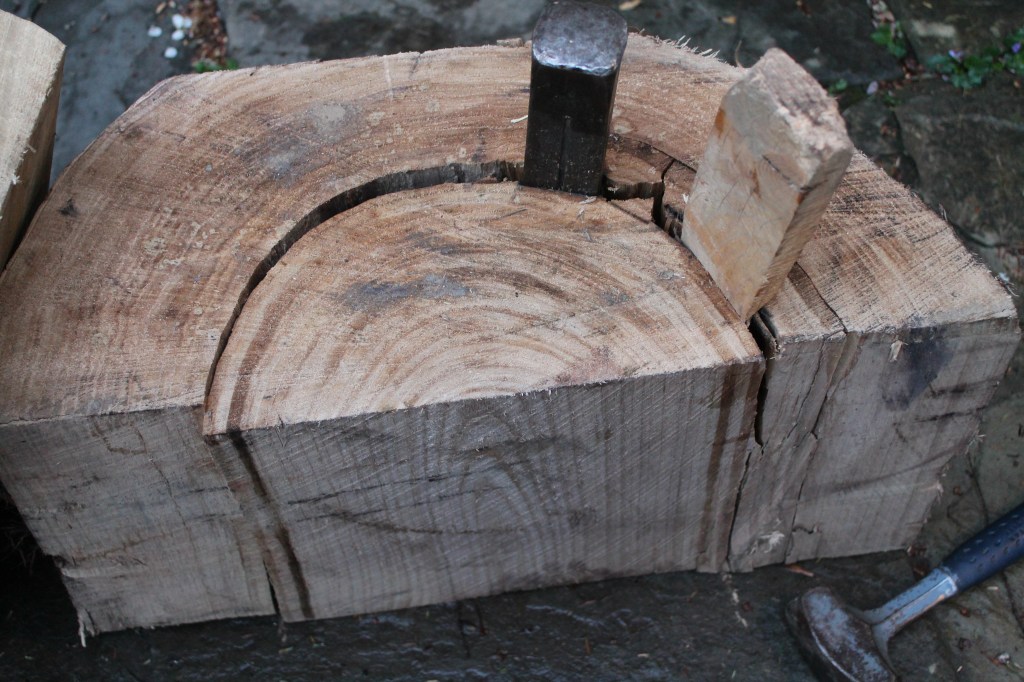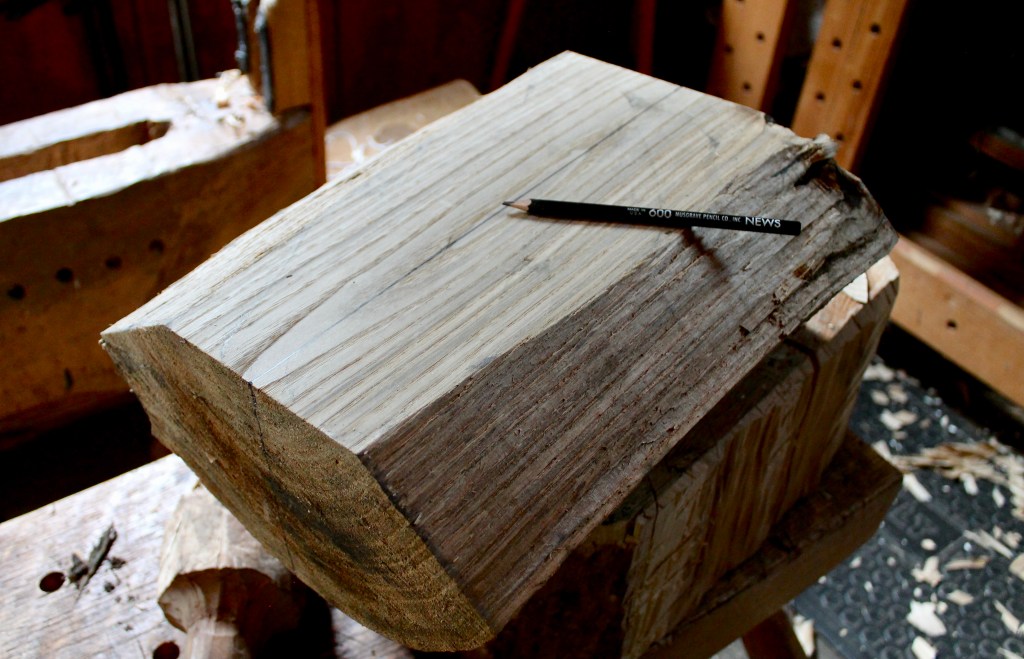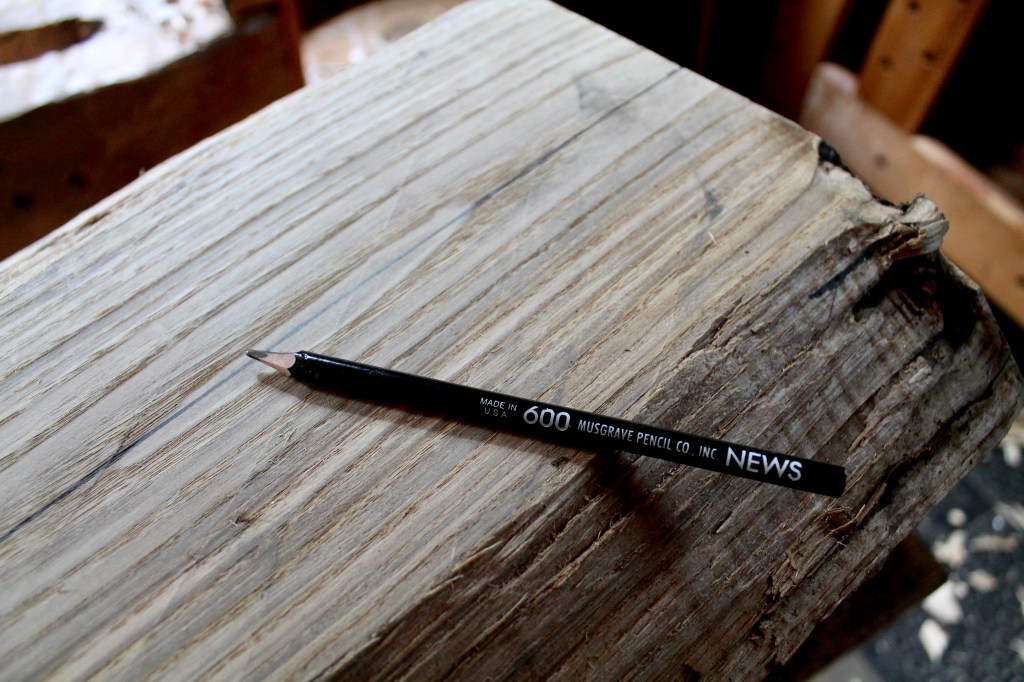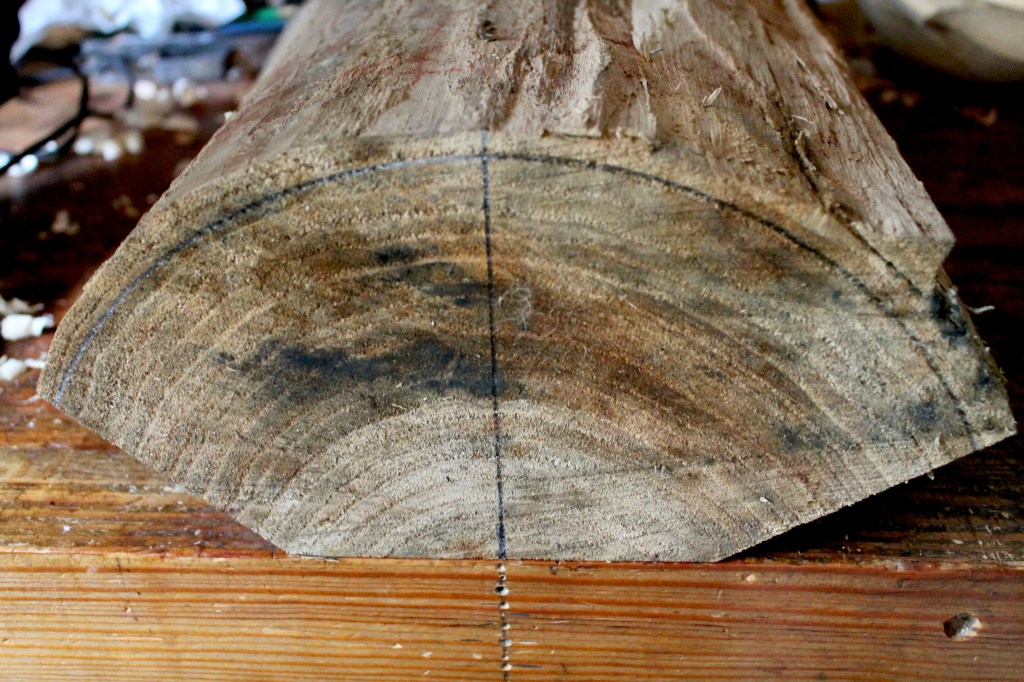
The solstice may still be a couple weeks away, but the first day of summer for me was yesterday. I celebrated by digging in to a special log. American chestnut. Big, green, American chestnut. I carved some chestnut a few years ago, but not this stuff.
Many readers of this blog are likely aware of the devastating blight that began killing the majestic American chestnut (Castanea dentata) trees in the early 1900s. In the 19th century, these mighty trees filled the woods in my area. Now they’re gone. But a rare stand planted in 1890 survived in Wisconsin until recently, when they too were hit by the blight. Details of that story can be found here. My understanding is that most of the hundreds of trees harvested last year from that stand were milled into lumber in Wisconsin. However, some of the trees were trucked to a veneer processing facility about a half-hour from my house here in Pennsylvania. One thing led to another, and I was asked to make a couple bowls from the cutoff ends of the veneer logs.

These chunks were massive, so even with the serious case of ring shake midway through the log, I was able to get usable material. You can see the fault line along the growth ring clearly on the left side, then a few rings away from it on the right side.

I was able to easily split out the central section, and that’s the blank I started with for this bowl. Notice, in the photo above, that the log was sawed at the plant. The cathedrals of the growth rings on the sawn face indicate that the sawcut runs at an angle to the growth rings, crossing five or so from one end to the other.

I hewed and planed that surface parallel to the growth rings and marked my longitudinal centerline along the bottom surface right through the center of them.

By the way, I recently discovered these pencils from the Musgrave Pencil Company in Shelbyville, Tennessee. They’ve been making pencils there since 1916. I like their pencils and the 600 NEWS model has a nice soft lead that marks really well on green wood without being so soluble that it bleeds into the fibers.

Once I marked the arc on both ends, I started in with the drawknife to remove the material beyond the line.

I love the drawknife work — especially.

Surprise. When I got close to the line, there was a bit of ring shake still present. I shaved past it, then marked new arcs just a little inside the originals.

I sight down as I go and a quick check with a straightedge verifies close-enough.

This chestnut bowl is well beyond layout now, but that’s enough for one post. More soon!

As an aspiring bowl carver, I love reading your “process” blog entries . I appreciate the details – how you approach the “bowl in log”, how you lay out, and how you deal with problems as they arise.
LikeLike
Thanks, Dan. Glad to know this approach is helpful. Happy carving!
LikeLike
Oooh, I love the rich color. We used a lot of chestnut in England as a lightweight, easily worked substitute for English oak (plainsawn). I love working with it but haven’t used American chestnut. I look forward to seeing this bowl when it’s finished.
LikeLike
I like the stories from your time in England in “Making Things Work,” Nancy. Glad the chestnut brought back some of the good memories from your experience there. Worth the bicycle trips perhaps!
LikeLiked by 1 person
Very nice, looking forward to the rest of the story.
LikeLiked by 1 person
David thanks for the blog.
Chestnut is very rot resistant; The woodlot where I live had some downed chestnuts in 1990 when I purchased it, and some of the logs, much smaller than your specimen, I saved all these years, not having enough for cabinetry projects. I actually have thought of bowl making from them, and was still working on my skills learned from your Fine Homebuilding videos, when I saw this post.
The wood is rather soft, and I purchased quite a bit of reclaimed chestnut from an outfit called the Joinery, in NC, in the late 1990s and did a whole room, floors, bookcases, etc, with their “wormy” chestnut. The flooring does dent and nick, it’s not oak or maple.
I planted some of the triple backcross seedlings from a majestic single remaining tree from Michigan , about 1995. There is some Chinese chestnut in these progeny, but not much. The trees are 30 feet high now, and look just like real American Chestnuts, are blight resistant, and produce a huge crop of nuts every year, that are really good.
The fungus came to the USA from logs shipped here from Norway. Why anyone wanted to buy Norwegian lumber in the 1880s when the upper midwest was so full of forests is beyond me. Like wooden pallets from China that have brought the emerald Ash borer here as well, to destroy the entire Ash forest.
M.R. Weiss
LikeLike
Do you have a link to an article with how you layout this style of bowl? Thanks
LikeLike
I describe that process in some published articles and videos. One is the Fine Woodworking article “Carve a Greenwood Bowl” that is listed here https://davidffisher.com/resources/published-articles/ Also, I go through the procedure in my Fine Woodworking video series and in my recorded online class with Elia Bizzarri. I have information about both of those here https://davidffisher.com/eventsteaching/ I’ve described the procedure so many times, but I guess I’ve never written a blog post with the steps/concept. I’ll try to remedy that soon. This particular bowl is going to have a narrow “side panel” just below the rim, which influences some of my layout choices in this case. More on that later too.
Thanks for the question.
LikeLike
Beautiful chunk of wood! How does it work? Thanks for the post.
Bob Simmons Sun City West, AZ
Sent from my iPad
>
LikeLike
I enjoyed working with it, Bob. The earlywood has quite large pores, so it would not be ideal for a cereal or salad bowl, but will be fine for a fruit bowl, bread bowl, etc. As expected lots of tannins to react with the iron in the tools, so I tried to remember to wipe the tools off after carving. Not a big deal. I do like the color and variation in the color from ring to ring.
LikeLike
Beautiful wood and its great that the trees were salvaged. It is sad that that we will not see this tree in our forests, due to the introduction of an invasive pathogen, so I look forward to seeing the completion of this bowl.
LikeLiked by 1 person
Here in GB we had a similar blight, Dutch Elm disease, in the 1970s. Apparently caused by importing elm with the bark on :(. Caused by a beetle I think (?). Our elm were very tall, towering over other trees. There was a row of them in the meadow behind our garden, site of a large rookery. They all succumbed and had to be felled.
Elms still grow here but now they only reach perhaps a quarter of their former size before succumbing to Dutch Elm disease. Shame.
Ash Dieback is our latest tree problem, across the country. Several ash tree owners in our village have felled theirs due to disease infection or fear of it (once the disease sets in, arborists won’t/can’t safely climb them to perform safe, segmented take down).
So sad. Such useful species too. We’ll have no trees left at this rate. New planting may exacerbate the problem, if trees are imported from, to or through infected areas. They may also serve to linked uninfected area with infected areas. Quite a dilemma.
LikeLike
We have another disease which affects horse Chestnut – conker trees – which has spread widely in recent years. Again, it reached our (rural) area. 😦
LikeLike
Yep, a real tragedy here as well, both with the Elms and the Ashes. The landscape is dotted with standing dead ash trees.
LikeLike
I’m midway through a turned and carved porringer in chestnut and have been enjoying the tangy scent of the wood. It’s hard to find out here in Coastal California, but a friend has a large chestnut tree that lost a side limb a few years back. I squirrelled away the usable bits of the limb and have been nibbling away at it ever since.
So many of our grand trees have been decimated by blights and fungus — ash, elm, chestnut, oaks… The forests are losing their elders.
LikeLike
Mine has a certain odor, Kalia, but not as tangy as fresh oak. I’ll be interested to see if it becomes more or less intense as it dries. It is hard to stomach the loss of these venerable trees. And the hemlocks are threatened now as well. So far the hemlocks in my neck of the woods have been spared.
LikeLike
What an Honor to get to work with a piece of green Chestnut! Thank you for this post. Can’t wait to see the rest of the process.
LikeLike
It’s great to continue to learn from you
LikeLiked by 1 person
Nicole here from Musgrave Pencil Co. Thank you for the mention of our News pencil!
LikeLike
Loving your other pencils too, Nicole. And I appreciate that a handwritten thank you note (in pencil) was on my receipt that accompanied my order.
LikeLike
Pingback: Chestnut Bowl: Forming a Full Hollow | David Fisher, Carving Explorations
Chestnut is so beautiful. It was quite common in my hometown, but that was a long time ago. I can’t wait to see your progress.
LikeLiked by 1 person
Pingback: Carving American Chestnut 4: Two Finished Bowls | David Fisher, Carving Explorations